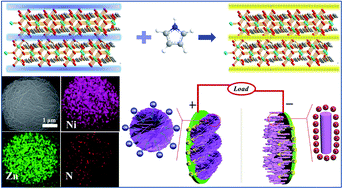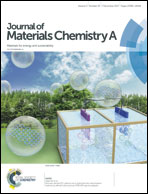Bimetal–organic framework assisted polymerization of pyrrole involving air oxidant to prepare composite electrodes for portable energy storage†
Abstract
The wide applications of metal–organic frameworks (MOFs) as supercapacitor electrodes are still hindered by their poor electrical conductivity. Herein, for the first time, conductive polypyrrole (PPy) has been incorporated into bimetal–organic frameworks to construct high performance supercapacitor electrodes (Zn/Ni-MOF@PPy). Interestingly, we found that the Zn/Ni-MOF could catalyze the polymerization of pyrrole into PPy using oxygen in air as the green oxidant. The conductive polymer chains not only increase the spacing between the layers of the Zn/Ni-MOF, but also provide favorable charge transport channels. The Zn/Ni-MOF@PPy shows outstanding electrochemical performance, and a “trade-off effect” between ion diffusion kinetics and electrical conductivity was discovered with different loads of PPy. Meanwhile, a coin-type hybrid supercapacitor (HSC) assembled using Zn/Ni-MOF@PPy and CNTs-COOH exhibits a high energy density of 50.9 W h kg−1 and a power density of 1338 W kg−1 simultaneously. Interestingly, the HSC exhibits remarkable cycling stability after 5000 cycles of charge–discharge. Hence, this strategy could open a new window toward the facile construction of MOF@PPy composite electrodes for portable energy storage applications.



 Please wait while we load your content...
Please wait while we load your content...